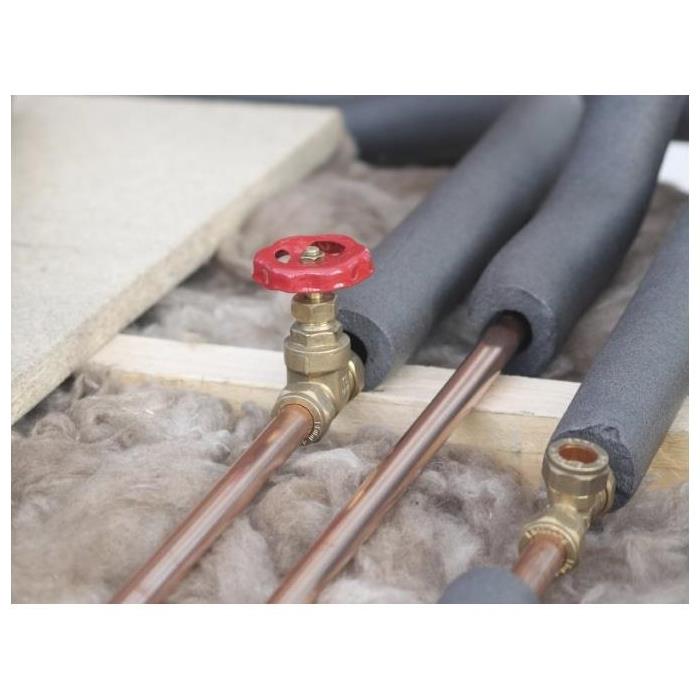Are Your Pipes Wrapped?
12/16/2022 (Permalink)
 Wrapping your pipes is the top way to reduce the risk of frozen or burst pipes during sub-freezing temperatures
Wrapping your pipes is the top way to reduce the risk of frozen or burst pipes during sub-freezing temperatures
With sub-freezing temperatures on the forecast for later this week, and the slight chance of snow or ice, homeowners are faced with a costly and dreadful situation… FROZEN PIPES! This can occur in homes with copper or plastic pipes and is the cause of about 1 in every 60 home insurance claims.
What Temperature Do Pipes Freeze and How Long Does It Take?
While the freezing temperature of water is 32°F, the pipes in your home are protected from exterior freezing temperatures by your home’s insulation. This does not become an issue until the outside temperature gets below 32°F. As a rule of thumb, the outside temperature needs to be 20°F or lower for six consecutive hours or more for your home’s pipes to start freezing. The amount of time it takes for your pipes to freeze is also dependent upon your home’s insulation, how far your water pipes are located inside your home, and if you have any exposed pipes.
Precautions to Prevent Pipes from Freezing and Bursting
The good news is that there are steps you can take to ensure this doesn’t happen to your home when these frigid temperatures arrive. By taking the preventative measures below, you can help protect your pipes from freezing and the resulting property damage that follows.
- Cover and insulate exposed pipes
- When your water supply pipes are exposed, or in an unheated space, they are more susceptible to freezing and bursting. Insulating your pipes is one of the cheapest and easiest ways to prevent frozen or busting pipes. Using fiberglass insulation wrap, self-sealing polyethylene wrap, or even pipe heat tape is a quick and easy way to insulate your pipes and a project you can knock out in an afternoon, giving you peace of mind during the winter months.
- Secure Outdoor Hoses, Valves, and Faucets
- Be sure to disconnect your garden hose from the outside faucet and, if applicable, use an indoor valve to shut off the water supply to the faucet and allow it to drain. As an extra measure of protection, install an insulated faucet sock or cover to the faucet to help reduce the chance of the faucet freezing and bursting inside your home.
- Keep a Consistent Temperature Inside
- Keeping your thermostat set at the same consistent temperature day and night can help reduce your risk of frozen pipes, and even reduce the strain on your HVAC unit. And, if you plan on being away for some time during the cold weather, leave the heat on and set your thermostat to no lower than 55° F.
- Open Kitchen and Bathroom Cabinet Doors
- Another small and useful strategy is to open the cabinet doors under your sinks. This allows the warm air from your home to circulate around your plumbing and keep your pipes warm. This is particularly important if your sink is located on an exterior wall as pipes in these areas are more prone to freezing from being closer to the cold outdoors.
- Let your Faucets Drip
- Though it seems counterintuitive, letting your faucets run can make a huge difference. You don’t have to leave your faucet running on full blast, but a trickle of hot and cold water keeps water moving through your pipes and helps prevent the lines from freezing.
- Seal Leaks and Drafty Areas of your Home
- When you have a gap or leak between the interior and exterior of your home, cold air is allowed to come in and lower the temperature around your pipes. With severely cold weather, even a tiny opening can let in enough air to cause a pipe to freeze. The most common areas for air to leak in are around window and door frames, electrical wiring, dryer vents, and pipes. Use calking or insulation to keep the cold out.
What To Do If Your Pipes Do Freeze or Burst
If it is below freezing and you notice that you are not getting water from one or more faucets, you likely have frozen pipes. Swift action is essential to thaw the pipe before it can burst.
- Shut off your water
- Try to find the frozen pipe
- Check for leaks
- Attempt to thaw
If you do find yourself in a situation with a burst pipe, be sure to give SERVPRO® Team Caldwell a call. We are available 24/7 with emergency restoration crews, a preferred vendor to many national insurance agencies, highly trained in water restoration techniques, and use s500 IICRC restoration standards to make your water damage “Like it never even happened! ®”





 24/7 Emergency Service
24/7 Emergency Service